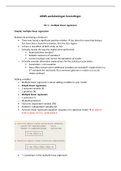Class notes
Hoorcollege aantekeningen ARMS Advanced Research Methods And Statistics ()
- Course
- Institution
This document is a very comprehensive summary of all ARMS lectures, which I listened very carefully online. All information has been typed out in detail, which is why the document is large. Thanks to my note, I got a 7.8 myself, although I'm not good at statistics.
[Show more]



